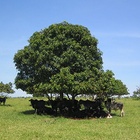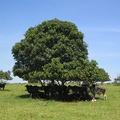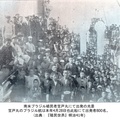"I saw a foreigner in town today!"
TA, who was an elementary school student at the time, reported this to his mother one day as he came home from school out of breath. TA must be over 80 years old now, so it's not surprising that something like this happened. For me, who lived in a prefectural capital, it was also in the early years of elementary school that the occasional foreigner I saw was so unusual that I couldn't take my eyes off them. Considering that I am only about half the age of TA, it was probably something that anyone would have experienced at that time... if it was in Japan.
Of course, I'm not going to tell you a Japanese folk tale here. TA-san experienced this in Brazil.
What kind of place was it where TA lived?
It is generally said that Japanese Brazilians are now quite assimilated, but this trend accelerated after the war. Until then, Japanese immigrants often lived together in newly developed areas, mainly in the countryside of the states of São Paulo and Paraná. Far from assimilation, these people lived a fundamentally Japanese lifestyle. The common language was, of course, Japanese, it was not uncommon to have a small Shinto altar in the room, and it was considered normal for Japanese immigrants to marry other Japanese immigrants.
These towns where Japanese people gathered were called "colonies," but a little later, from the end of the Taisho era to the beginning of the Showa era, several "Japanese settlements" were established. These were even more Japanese than the "colonies."
The reason why the "Japanese settlements" were more Japanese than the "colonies" is that the latter were established by people who had immigrated to Brazil and worked as contract laborers before becoming landlords, while the former included many people who had immigrated directly from Japan as landlords. It also seems that the fact that the settlements were quickly equipped with various facilities such as schools, hospitals, and industrial facilities through the efforts of the mother country's government in the name of so-called national migration policy may have had some influence. Some people who struggled in Brazil looked coldly at the "Hinomaru settlements," which they called "Japanese flag settlements," but it is possible to imagine that, protected by the Hinomaru flag, they were able to live a Japanese life in a somewhat unreserved way.
The place where TA lived was one of those Japanese settlements.
The settlement where TA grew up - let's call it Settlement A - has now been incorporated as a city with a population of just over 20,000, but it was originally complete wilderness that was developed by Japanese people who cleared land. It is located about 500 kilometers from São Paulo towards the interior of the state.
For a "settlement area" to be Japanese, it naturally needs to have an overwhelming number of Japanese people. The story of TA introduced at the beginning is one of those episodes that shows just how Japanese people were in the end.
There are many other stories that show the large number of Japanese people in settlement A.

An elementary school in a Japanese settlement in Brazil at the beginning of the Showa era. Courtesy of Tadakimi Takeshita
To help us understand visually, I think this photo is just right. It is a group photo of an elementary school. It was taken in the schoolyard around 1933.
This school was located in the center of settlement A. Although about ten elementary schools would eventually be established in the settlement, this one was always the largest, with over 300 students enrolled at its peak.
In total, there are roughly 200 children and less than 10 people who appear to be teachers. Please try to look closely and see if you can find any students who look different from Japanese people. It probably just looks like a group photo of an ordinary elementary school in old Japan. If you were told that it was a Brazilian elementary school, you would probably be confused.
Of course, this school did not only admit Japanese students, it was the only one in the area, it was just that the school, located in Brazil, had almost entirely Japanese students.
Young people in Japan today know to some extent that there were Japanese who emigrated to Brazil, and that there were apparently a lot of them. However, very few people actually know what kind of life Japanese immigrants led in Brazil (I was like that until quite recently, so I think I can be forgiven for saying this with certainty).
In such a situation, the number of people who know about "Japanese settlements" is likely to be even more limited.
In the next few posts, I would like to write down the story of the Japanese settlement in Brazil (remnants of which still remain today). I think it would be good for more people to know about this strange town that once existed in Brazil, where no matter which way you looked there were only Japanese people.
© 2007 Shigeo Nakamura










